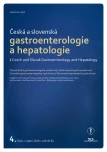The role of ultrasound in diagnostics of bowel disease
Authors:
D. Bartušek; M. Vavříková; V. Válek; J. Hustý
Authors‘ workplace:
Radiologická klinika FN Brno-Bohunice a LF MU Brno
Published in:
Gastroent Hepatol 2010; 64(4): 18-24
Category:
Review Article
Overview
This article summarises the possibilities of ultrasound imaging of the small and large bowel. Bowel ultrasound plays an important role above all in patients with Crohn’s disease, but it could be used in other bowel pathological conditions as well. Due to its non-invasiveness, availability and imaging efficiency, it is a suitable imaging modality both in first line diagnostics and in long-term follow-up in patients with chronic diseases such as IBD. Ultrasound is able to image not only the bowel wall and to separate bowel wall layers, but also the changes in the surroundings tissue or organs such as mesentery, which is able to increase the sensitivity of the method for disease activity assessment. Recently, there has been a tendency to use ultrasound contrast agents, which should allow a more precise assessment of activity of inflammatory processes.
Key words:
imaging methods – ultrasound – diagnostics – follow up – small bowel – large bowel
Sources
1. Válek V. Tenké střevo, radiologicko-patologické stavy. Brno 2003.
2. Maconi G, Sampietro GM, Satani A et al. Bowel ultrasound in Crohn's disease: surgical perspective. Int J Colorectal Dis 2008; 23(4): 339–347.
3. Tarján Z, Tóth G, Györke T et al. Ultrasound in Crohn's disease of the small bowel. Eur J Radiol 2000; 35(3): 176–182.
4. Castiglione R, Rispo A, Cozzolino A et al. Bowel sonography in adult celiac disease: diagnostic accuracy and ultrasonographic features. Abdom Imaging 2007; 32(1): 73–77.
5. Rettenbacher T, Hollerweger A, Macheiner P et al. Adult Celiac Disease: US Signs. Radiology 1999; 211(2): 389–394.
6. Parente F, Greco S, Molteni M et al. Modern imaging of Crohn's disease using bowel ultrasound, Inflamm Bowel Dis 2004; 10(4): 452–461.
7. Serra C, Menozzi G, Labate AM. Ultrasound assessment of vascularization of the thickened terminal ileum wall in Crohn's disease patients using a low-mechanical index real-time scanning technique with a second generation ultrasound contrast agent. Eur J Radiol 2008; 65(2): 242–243.
8. Schreyer AG, Finkenzeller T, Gössmann H et al. Microcirculation and perfusion with contrast enhanced ultrasound (CEUS) in Crohn's disease: first results with linear contrast harmonic imaging (CHI). Clin Hemorheol Microcirc 2008; 40(2): 143–155.
Labels
Paediatric gastroenterology Gastroenterology and hepatology SurgeryArticle was published in
Gastroenterology and Hepatology

2010 Issue 4
- Metamizole vs. Tramadol in Postoperative Analgesia
- Metamizole at a Glance and in Practice – Effective Non-Opioid Analgesic for All Ages
- Metamizole in perioperative treatment in children under 14 years – results of a questionnaire survey from practice
- Obstacle Called Vasospasm: Which Solution Is Most Effective in Microsurgery and How to Pharmacologically Assist It?
- Possibilities of Using Metamizole in the Treatment of Acute Primary Headaches
Most read in this issue
- The role of ultrasound in diagnostics of bowel disease
- Risk of combining clopidogrel with proton pump inhibitors – significance and possible solutions
- Eosinophilic gastroenteritis as a rare cause of ascites
- Getting “Un” Constipated in the 21st Century (Constipation… the “Low-Serotonin Syndrome”)
